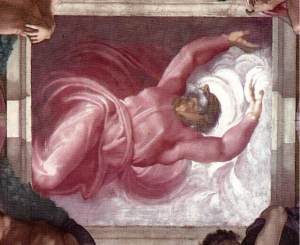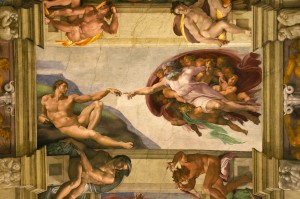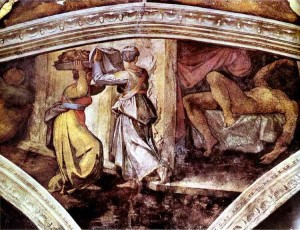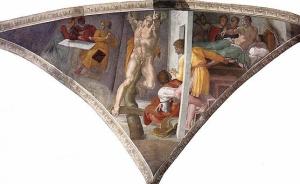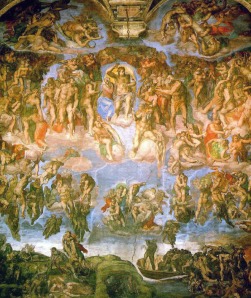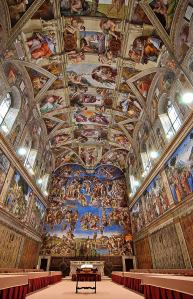Introductory Statement
Michelangelo Buonarroti was born on March 6, 1475. He lived almost a full century and died on February 18, 1564, working six days before his death. During Michelangelo’s life the world underwent a remarkable period of change since the decline of the Roman Empire. The Renaissance saw change in all aspects of life and culture. Michelangelo was one of the most enthusiastic advocates of this exciting new philosophy, working with a remarkable energy that was mirrored by contemporary society (Bradbury 6).
On May 10, 1508, Pope Julius II gave Michelangelo commission, which drastically changed the way in which Michelangelo saw himself and his art. Until this point Michelangelo had been by definition, a sculptor, yet the pope commissioned him to fresco the celling of the Sistine Chapel. Michelangelo had to learn the art of painting, just as he did sculpting as a teenager. Michelangelo became frustrated from the difficult task and looked to his former master, Ghirlandaio, for assistance with the technique of fresco painting.
Between 1508 and 1512, Michelangelo painted over 300 figures on to the ceiling. The scenes were not always depicted in the expected, conventional and traditional manner of the time. This is most notable in Michelangelo’s Garden of Eden, where both Adam and Eve are seen equally guilty for their downfall after eating from the Tree of Knowledge. October 21, 1512 Michelangelo was able to finish the ceiling; a task that was difficult in the extreme (Bradbury 11).
To reach the chapel’s ceiling, Michelangelo designed his own scaffold, a flat wooden platform on brackets built out from holes in the wall near the top of the windows, rather than being built up from the floor. Contrary to popular belief, he painted in a standing position, not lying on his back. According to Vasari, “The work was carried out in extremely uncomfortable conditions, from his having to work with his head tilted upwards”. Michelangelo described his physical discomfort in a humorous sonnet accompanied by a little sketch (Reisman 170).
The purpose of this virtual exhibition is to show that Michelangelo was able to produce such amazing fresco paintings that have lasted over 500 years and are so well known, even though he was considered to be just a sculptor before. Michelangelo had a difficult task in painting over 5,000 square feet of the ceiling let alone needing to figure out the technique behind fresco panting. Once Michelangelo was able to get the technique down he was painting like a man on fire and was able to finish in just four years.
The Separation of Light from Darkness
Chronologically the first panel in thee narrative is The Separation of Light from Darkness but is seen last if entering the Sistine Chapel through the lay entrance. Michelangelo chose to begin panting here and worked back towards the altar wall. The first five panels depict the creations of God, beginning here with Creation of Form from Chaos (The Separation of Light from Darkness). The narrative then moves on to highlight the Biblical history of mankind, starting with the fall of man, followed by the panels that show stories of Noah and The Flood.
Michelangelo was the first artist to attempt the illustration of such an ethereal and intangible subject as the beginning of the universe and he chose a literal translation of the bible, focusing on the figure God.
In the Separation of Light from Darkness God fills almost the entire panel as he reaches ahead with both hands. God appears to be moving because of the swirling colors around him. By Gods left hand the color white fills half of the panel representing light. around Gods right hand is a dark gray or black which represents darkness. Like in all the other panels depicting God clothed in pink (Bradbury 64).
Creation of Plants, and the Sun, and Moon
The painting, The Creation of the Sun, Moon, and Planets is a fresco on the ceiling of the Sistine Chapel. From 1508 to 1512, the Michelangelo painted it and it is the second panel of the series of nine on the ceiling. The Creation of the Sun, Moon, and Planets is based on the biblical creation of the universe from Genesis 1:6-8. Many symbols in the painting make a direct reference to the Bible. It displays a very clear interpretation of how the universe came to be.
Following on from The Separation of Light from Darkness is the Creation of Plants, and the Sun, and Moon. This painting is a continuous narrative depicting God in two of his acts of creating, so he is seen twice within the sequence of the panel.
On the right of the scene, by Gods far-flung left hand, is the vague, grey outline of the moon at which one of Gods fingers is pointing. Next to the outstretched right hand, God is points to the huge globe of the sun which is a burnt orange as if it’s the color of the sun seen at dawn. The fierce appearance of Gods concentration seen by his furrowed brow and piercing stare. He looks like a “God in action,” immensely powerful and with the potential for a dangerous anger. Under his outstretched arms, among his swirling robe, is two cherubs or angles that are gazing up at God in awe from his incredible power.
The left is the second part of the panel’s narrative, foreshadowing God leaving the ceiling fresco, on his way to his next task. The panel depicts God from an unusual view-point. God is viewed from the back, seeing the souls of his feet as he flies though the air. One of Gods arm is stretching towards the green land beneath him, creating the land and foliage of the earth (Bradbury 67).
The Creation of Adam
The Creation of Adam is a fresco painting by Michelangelo, forming part of the Sistine Chapel ceiling, painted approximately 1511–1512. It illustrates the Biblical creation narrative from the Book of Genesis in which God breathes life into Adam, the first man.
The notion of God creation man had been represented in Art before Michelangelo began working on the Sistine Chapel, but never with the same majesty and vitality that Michelangelo achieved. What makes The Creation of Adam so different is the treatment was not purely reserved for the figure of God but still equally abundant, of God’s creation of a being in his own image.
Adam has been painted nude, a massive figure that reclines against a rocky mountain, in between an otherwise barren landscape. Adam is perfectly poised, having perfection of form being muscular but with beautiful proportions. Adam has the appearance of being weak because his arm is resting on his knee like it is too heavy for him to hold it up without support. His hand also looks limp and fingers are drooping as if he is without energy and is waiting the spark of life.
God is shown in movement as he is in the preceding three that portray images of his creation. The gesture of the angles and cherubs that ling to his side, emphasize Gods movement. Some of the of the angels and cherubs watch closely as Adams and Gods hands draw close. Unlike Adam God is shown wearing close.
The scale with The Creation of Adam is lager that the preceding panels. Michelangelo decided to increase the size of figures and decrease the detail, making the painting more impressive and startling to the audience bellow.
The Hand of God is a detail from The Creation of Adam. The panel illustrates the movement when life is instilled in Adam by God. Michelangelo has place the central focus upon the hands of God and Adam, not just by the placement of the fingers, but also by the lines of form that flow within the painting between the two outstretched arms (Bradbury 73).
Creation of Eve
The figure of Eve has none of the majesty and heroic form of Adam in The Creation of Adam. Eve’s body is hunched, her hands are clasped tightly together and she reaches up, towards God who is standing in front of her. Eve appears obsequious as God blesses her. The Creation of Eve is a small panel and Michelangelo has painted the figure God as an immense form, clothed in his heavy pink robes, and his head slightly bent forward in order for him to fit within the panel.
In the bottom left corner a fiery headed Adam lies unconscious against a dead tree. Michelangelo did this to remind the viewer that Eve was formed from one of Adam’s ribs and also that she will bring about the Fall of Man and the Loss of Paradise.
The colors used within this panel are repeated in the objects that the surrounding Ignudi hold and are themselves echoes of the hues from The Fall of man and the Expulsion from Paradise. The recent problematic restoration of the Sistine Chapel ceiling revealed Michelangelo’s original intense use of color once the dirt of almost 500 years had been removed (Bradbury 76).
Fall of Man and the Expulsion from Paradise
The sixth scene in the chronological order of the narrative is the Fall of Man and the Expulsions from Paradise. The story of the Fall of Man from the book of Genesis is one of the most famous stories in Western culture. Adam and Eve had everything they wanted but disobeyed God’s word to have a bite from the tree of knowledge and were then banished from the Garden of Eden to live in the wilderness and be subject to a mortal life (Interpretations of Genesis Frescos).
Generations of artist before Michelangelo depicted these two scenes separately. Michelangelo used the same device of continuous narrative for this large panel of Fall of Man and the Expulsion from Paradise that he used in The Creation of Plants, the Sun, and Moon. The tale starts on the left, with the figure of Adam grabbing the branches of the tree while Eve sits beneath him. Eve reaches behind her to take the Apple from the serpent.
The serpent from the Garden of Eden is usually portrayed as a male or genderless. Michelangelo chose a feminine depiction for his serpent, tempting the eagerly awaiting Eve with the forbidden fruit while also focusing her gave upon Adam. The serpent upper half takes the form of a tempting woman. This means that pictorially, women is blamed twice for the fall and expulsion.
On the right of the fresco, Adam and Eve are shown leaving Eden. Adam is shown leaving the scene, his hands sheltering his eyes from the sight as they are pushed out of paradise by an angel hovering above. Eve looks back, her body hunched forward with her hand against her face as if trying to hide herself in shame. Both Adam and Eve look aged compared to them on the left (Bradbury 80).
The Sacrifice of Noah
Chronologically the story of Noah’s sacrifice belongs after the Flood, but the story of the flood required a larger panel due to the amount of figures it was to contain. This smaller panel was the last Michelangelo painted before he changed the scale within his fresco. The following panel, The Fall of Man, shows fewer and larger figures which enhanced visibility.
In the background, behind the table, is the figure of Noah, one arm raised as if preaching to his family, trying to gain some order. On his left his daughter-in-law raises her hand and turns her head away, not willing to hear his words. Noah’s wife stands on his right, whispering words into his ear. In front of Noah and the table, Noah’s three sons are busy with their preparations for the sacrifice they are to make in praise God. They grab and hold the animals to be slaughtered, one sitting on a ram, while another son pulling a ram by his horns (Bradbury 85).
The Flood
The Flood was believed to have been the first narrative panel that Michelangelo painted. The Flood is a wealth of images crowed together and is the smallest of the nine panels. When viewed from the floor of the chapel it is difficult to make out the finer points of the piece. It is thought that Michelangelo changed the scale of the other panels after seeing The Flood from the ground, as all the other panels have larger fewer figures.
Given the similarities in their subject matter, The Flood bears a great resemblance to the later fresco, The Last Judgment, with both paintings having a mass of troubled bodies.
I the foreground of the picture, a women lies despondent on the hillside. Behind her a long line of people, some bearing children, women, or belongings. They are all struggling up the hillside, in an attempt to gain sanctuary from the rising water. One figure clings to a tree frantically as the tree bends in the wind. To the right, a man carries the lifeless body of another toward a tent full of huddled people, who are reaching out their arms to help. The compassionate portrayal of the people fades in the background where figures can be seen fighting each other on the boat and again on the Ark (Bradbury 86).
In the middle of the sky, there is a large patch that has been replaced, and the loss continues into the Ignudo above. This is one of the very few losses which the ceiling has sustained. The excellent condition of the frescos today is a tribute to Michelangelo’s technique, so it is interesting that this mural painting, which was the first he worked on, was the weakest. The 16th century artist and Mannerist biographer Giorgio Vasari (1511-74) reported that shortly after the artist began painting he discovered mold growing on the plaster indicating that it was not drying properly. He was then advised that for the Roman climate he needed to add more sand to his plaster – which he did, after which he had no further problems (Interpretations of Genesis Frescos).
Judith Carrying the Head of Holofernes
At the corner of the ceiling are four spandrels which Michelangelo used to illustrate stories of the saviors of Jews. In one of these spandrels over the lay entrance of the chapel, Michelangelo painted the story of Judith Carrying the Head of Holoferns.
The account of the beheading of Holofernes by Judith is given in the deuterocanonical book of Judith, and is the subject of more than 114 paintings and sculptures. In the story, Judith, a beautiful widow, is able to enter the tent of Holofernes because of his desire for her. Holofernes was an Assyrian general who was about to destroy Judith’s home, the city of Bethulia, though the story is emphatic that no “defilement” takes place. Overcome with drink, he passes out and is decapitated by Judith.
In the center of the painting, two women leave a bed chamber in which the body of the naked Holofernes lies, with his knee bent and his torso facing away from the viewer so that his neck cannot be seen. Judith looks at Holofernes body as she lifts a sheet to cover the head that her maid carries in a tray (Bradbury 106).
Esther And Haman
One of the four corner spandrels, Esther and Haman tells the story of Esther, the wife of a Persian king who denied her Jewish heritage until Haman, the king’s minister, planned to slaughter all Jews. Esther appealed to her king on behalf of the Jews and Haman was subsequently executed. The tale of Esther augurs Mary’s pleading for mankind on Judgement Day, connecting this panel with the later fresco The Last Judgment possitioned on the right.
Ester and Haman is another continuous narative. To the left of the narative is Esther denounces Haman. Next to Haman is seen greeting Mordecai , who he plots to have hanged. To the right of the scene the king lies awake in bed. Finaly in the centertral doninate image of the piece is of the contorted figure of Haman being crucified.
Michelangelo has paintedd the figure of Haman as if he was runing. The cross he is on is twisted so that his limbs are flung out and in front of his body rather the usual side positon. The suggestion of movement in the trappedd body is symbolic of Haman’s desperate struggle to free himself (Bradbury 105).
The Last Judgment
Pope Julius II had originally conceived the idea of covering the alter wall of the Sistine Chapel in St Peter’s, Rome, with a depiction of the Resurrection of Christ, a theme that would have complimented the ceiling’s overall theme of the creation and downfall of man. The plans for the alter reemerged following a fire which damaged the altarpiece by Pietro Perugino. Pope Paul III who appointed Michelangelo as his chief painter,sculptor, architect, gave him him the commission for the fresco in 1534. At the time Michelangelo was yet again trying to complete the doomed project of the Tomb of Pope Julius II, but Paul III intervened, insisting that the artist should work on his project instead
The alter wall is 40 feet wide by 45 feet high, making The Last Judgment the largest single undivided work of art to be undertaken by a single individual. At what point the theme of the Resurrection became The Last Judgment is unclear, although it is most probable that Pope Paul III, a strong reformist, influenced the change.
Michelangelo has placed Christ centrally , near the top of the painting. A dense ring of figures has formed around Christ. These figures are the souls that have already risen and are bound for heaven. Underneath his right arm is Marry, who is turning her head away as Christ makes his final judgment.
The flayed, gray skin that St Bartholomew holds contains a self portrait of Michelangelo. This ironic gesture proves to be prophetic when viewed in the light of the arguments that surrounded The Last Judgment. When he was asked by Pope Paul III to make the fresco “more suitable”, following comments that it would be more fittingly displayed in a brothel, Michelangelo replied, “make the world a suitable place and the painting will follow suit.”
Annotative Bibliography
Bradbury, Kirsten. Essential Michelangelo. Bath: Parragon, 2000. Print.
In the book Essential Michelangelo, Bradbury takes many of Michelangelo’s work like the statue of David and his many fresco paintings in the Sistine Chapel and has a description of the works.
“Interpretation of Genesis Frescoes (1508-12).” Genesis Fresco, Sistine Chapel, Michelangelo: Interpretation, Analysis. N.p., n.d. Web. 06 Nov. 2013.
In the Interpretation of Genesis Frescoes there many descriptions of Michelangelo’s fresco painting in the Sistine Chapel but not all his work. There is also a description of the background behind that time period and the art that was popular.
Reisman, Rosemary M. Canfield. Italian Poets. 4th ed. Ipswich, MA: Salem, 2012. Print.
Italian Poets is a book that profiles the lives, achievements and important works of major poets. In the book there is a chapter about Michelangelo’s life and his work not only his poetry but sculptures and paintings as well.

